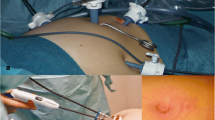Abstract
Background
This study aimed to compare single-port transumbilical total laparoscopic hysterectomy (SPLS-TLH) and four-port total laparoscopic hysterectomy (TLH) in terms of postoperative pain.
Methods
The study enrolled 68 patients who underwent TLH from October 2009 to March 2010 and randomly assigned them to one of two groups. Patient demographics, operative outcomes, and postoperative pain were prospectively examined.
Results
Four cases in the SPLS-TLH group were converted to other laparoscopic approaches. The two study groups did not differ in terms of patient demographics and surgical outcomes. Postoperative pain scores, measured using a visual analog scale, did not differ between the two groups. However, significantly higher total requests for analgesics were observed in the SPLS-TLH group (11.3 ± 4.1 vs. 7.7 ± 2.7; p < 0.001).
Conclusion
Compared with four-port TLH, SPLS-TLH is a feasible approach with comparable operative outcomes. However, reduction of postoperative pain is not evident with SPLS-TLH.


Similar content being viewed by others
References
Wu JM, Wechter ME, Geller EJ, Nguyen TV, Visco AG (2007) Hysterectomy rates in the United States, 2003. Obstet Gynecol 110:1091–1095
Johnson N, Barlow D, Lethaby A, Tavender E, Curr E, Garry R (2006) Surgical approach to hysterectomy for benign gynaecological disease. Cochrane Database Syst Rev CD003677
Pelosi MA, Pelosi MA III (1991) Laparoscopic hysterectomy with bilateral salpingo-oophorectomy using a single umbilical puncture. N J Med 88:721–726
Lee YY, Kim TJ, Kim CJ, Kang H, Choi CH, Lee JW, Kim BG, Lee JH, Bae DS (2009) Single-port access laparoscopic-assisted vaginal hysterectomy: a novel method with a wound retractor and a glove. J Minim Invasive Gynecol 16:450–453
Lim MC, Kim TJ, Kang S, Bae DS, Park SY, Seo SS (2009) Embryonic natural orifice transumbilical endoscopic surgery (E-NOTES) for adnexal tumors. Surg Endosc 23:2445–2449
Jung YW, Kim SW, Kim YT (2009) Recent advances of robotic surgery and single-port laparoscopy in gynecologic oncology. J Gynecol Oncol 20:137–144
Jung YW, Kim YT, Lee DW, Hwang YI, Nam EJ, Kim JH, Kim SW (2010) The feasibility of scarless single-port transumbilical total laparoscopic hysterectomy: initial clinical experience. Surg Endosc 24:1686–1692
Fader AN, Escobar PF (2009) Laparoendoscopic single-site surgery (LESS) in gynecologic oncology: technique and initial report. Gynecol Oncol 114:157–161
Breivik H, Borchgrevink PC, Allen SM, Rosseland LA, Romundstad L, Hals EK, Kvarstein G, Stubhaug A (2008) Assessment of pain. Br J Anaesth 101:17–24
Kim TJ, Lee YY, Cha HH, Kim CJ, Choi CH, Lee JW, Bae DS, Lee JH, Kim BG (2010) Single-port access laparoscopic-assisted vaginal hysterectomy versus conventional laparoscopic-assisted vaginal hysterectomy: a comparison of perioperative outcomes. Surg Endosc 24:2248–2252
Tsimoyiannis EC, Tsimogiannis KE, Pappas-Gogos G, Farantos C, Benetatos N, Mavridou P, Manataki A (2010) Different pain scores in single transumbilical incision laparoscopic cholecystectomy versus classic laparoscopic cholecystectomy: a randomized controlled trial. Surg Endosc 24:1842–1848
Bisgaard T, Klarskov B, Trap R, Kehlet H, Rosenberg J (2000) Pain after microlaparoscopic cholecystectomy: a randomized double-blind controlled study. Surg Endosc 14:340–344
Leggett PL, Churchman-Winn R, Miller G (2000) Minimizing ports to improve laparoscopic cholecystectomy. Surg Endosc 14:32–36
Poon CM, Chan KW, Lee DW, Chan KC, Ko CW, Cheung HY, Lee KW (2003) Two-port versus four-port laparoscopic cholecystectomy. Surg Endosc 17:1624–1627
Drahonovsky J, Haakova L, Otcenasek M, Krofta L, Kucera E, Feyereisl J (2010) A prospective randomized comparison of vaginal hysterectomy, laparoscopically assisted vaginal hysterectomy, and total laparoscopic hysterectomy in women with benign uterine disease. Eur J Obstet Gynecol Reprod Biol 148:172–176
Alexander JI, Hull MG (1987) Abdominal pain after laparoscopy: the value of a gas drain. Br J Obstet Gynaecol 94:267–269
Korell M, Schmaus F, Strowitzki T, Schneeweiss SG, Hepp H (1996) Pain intensity following laparoscopy. Surg Laparosc Endosc 6:375–379
Sharp JR, Pierson WP, Brady CE III (1982) Comparison of CO2- and N2O-induced discomfort during peritoneoscopy under local anesthesia. Gastroenterology 82:453–456
Vitale GC, Collet D, Larson GM, Cheadle WG, Miller FB, Perissat J (1991) Interruption of professional and home activity after laparoscopic cholecystectomy among French and American patients. Am J Surg 161:396–398
Chow A, Purkayastha S, Aziz O, Paraskeva P (2010) Single-incision laparoscopic surgery for cholecystectomy: an evolving technique. Surg Endosc 24:709–714
Acknowledgments
This study was supported by the Brain Korea (BK) 21 project for medical sciences, Yonsei University, and by a National Research Foundation of Korea grant funded by the Korean government (2009-0071158).
Disclosures
Yong Wook Jung, Maria Lee, Ga Won Yim, San Hui Lee, Ji Heum Paek, Ha Yan Kwon, Eun Ji Nam, Sang Wun Kim, and Young Tae Kim have no conflicts of interest or financial ties to disclose.
Author information
Authors and Affiliations
Corresponding author
Additional information
Yong Wook Jung and Maria Lee equally contributed to this work as co-first author.
Rights and permissions
About this article
Cite this article
Jung, Y.W., Lee, M., Yim, G.W. et al. A randomized prospective study of single-port and four-port approaches for hysterectomy in terms of postoperative pain. Surg Endosc 25, 2462–2469 (2011). https://doi.org/10.1007/s00464-010-1567-z
Received:
Accepted:
Published:
Issue Date:
DOI: https://doi.org/10.1007/s00464-010-1567-z




